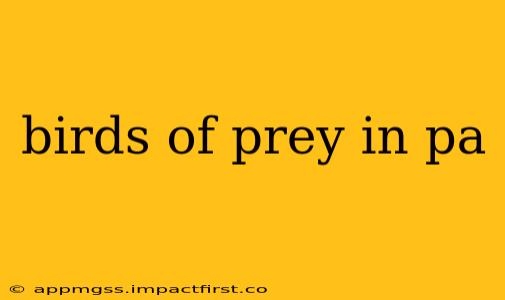Pennsylvania, with its diverse habitats ranging from forests and mountains to wetlands and farmland, boasts a rich variety of birdlife, including a fascinating array of birds of prey. These magnificent raptors play a crucial role in the state's ecosystem, controlling rodent populations and contributing to biodiversity. This guide explores the diverse birds of prey found in PA, their habitats, and their conservation status.
What birds of prey are common in Pennsylvania?
Pennsylvania is home to several species of birds of prey, each with unique characteristics and ecological roles. Some of the most common include:
-
Red-tailed Hawk: This ubiquitous hawk is perhaps the most frequently sighted raptor in Pennsylvania. Its characteristic reddish tail and soaring flight make it easily identifiable. They are highly adaptable and can be found in a wide range of habitats, from forests and fields to urban areas.
-
Broad-winged Hawk: These hawks are known for their distinctive broad wings and their impressive migratory gatherings. They breed in Pennsylvania's forests and can be seen in large numbers during their spring and fall migrations.
-
Cooper's Hawk: A skilled hunter of birds, the Cooper's hawk is a medium-sized raptor with a long tail and powerful wings. They inhabit wooded areas and are often seen pursuing prey through dense vegetation.
-
Sharp-shinned Hawk: Similar in appearance to the Cooper's hawk, the sharp-shinned hawk is smaller and more slender. It is also a bird specialist, often preying on smaller songbirds.
-
Northern Goshawk: This large, powerful hawk is less common than other species on this list, preferring mature coniferous and mixed forests.
-
American Kestrel: The smallest falcon in North America, the American kestrel is a colorful bird with a distinctive rufous back and a blue-gray head. They can be found in open areas with scattered trees and power lines.
-
Bald Eagle: Pennsylvania's state bird is a majestic sight to behold. While once endangered, successful conservation efforts have led to a remarkable recovery in their population, and they are now a relatively common sight along rivers and lakes.
-
Osprey: These fish-eating hawks are frequently seen near water bodies, where they skillfully dive to catch their prey. They are known for their large size and distinctive white underparts.
-
Great Horned Owl: A formidable nocturnal hunter, the Great Horned Owl is Pennsylvania's largest owl. They inhabit a variety of wooded habitats.
Where can I see birds of prey in Pennsylvania?
Pennsylvania's diverse landscape provides numerous opportunities for birdwatching, including excellent spots for observing birds of prey. State parks, wildlife refuges, and even urban green spaces can offer glimpses of these magnificent birds. Some notable locations include:
- Hawk Mountain Sanctuary: Famous for its annual hawk migration, this sanctuary offers incredible viewing opportunities.
- Presque Isle State Park: The park's diverse habitats support a variety of bird species, including several raptors.
- Delaware Water Gap National Recreation Area: This scenic area provides ideal habitat for several species of birds of prey.
Consulting local birdwatching groups and online resources can provide up-to-date information on the best locations for spotting birds of prey in specific areas of Pennsylvania.
What is the best time of year to see birds of prey in PA?
The best time to see birds of prey in Pennsylvania depends on the species. Spring and fall migration periods (typically September to October and March to April) are excellent times to witness large numbers of hawks migrating. Winter offers opportunities to spot resident species like Great Horned Owls and Bald Eagles. Summer months are ideal for observing breeding birds and their nests.
What are the threats to birds of prey in Pennsylvania?
Birds of prey, like many other wildlife species, face a range of threats in Pennsylvania, including:
- Habitat loss: Deforestation and urban sprawl are reducing the available habitat for many raptors.
- Pesticides: Exposure to pesticides can weaken their immune systems and affect their reproductive success.
- Collisions with vehicles and power lines: These are significant causes of mortality for birds of prey.
- Lead poisoning: Ingestion of lead shot from hunted prey is a serious threat.
How can I help protect birds of prey in Pennsylvania?
We can all play a role in protecting these magnificent creatures. Supporting conservation organizations, practicing responsible land management, and being mindful of our impact on the environment can all make a difference. Responsible birdwatching practices, such as maintaining a safe distance, are also crucial.
By understanding the challenges faced by birds of prey in Pennsylvania and taking proactive steps to protect their habitats, we can ensure these magnificent birds continue to grace our skies for generations to come.
